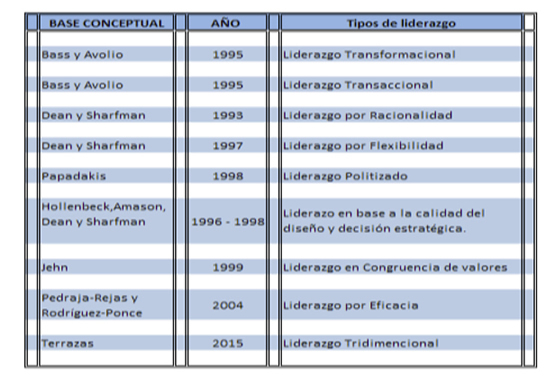
doi.org/10.15198/seeci.2017.44.155-170
SEARCH
ANALYSIS OF LEADERSHIP AND ITS RELATIONSHIP WITH LABOR MOTIVATION IN S.E.R.L.I. SOCIETY PRO-REHABILITATION IN GUAYAQUIL IN THE YEAR 2016
ANÁLISIS DEL LIDERAZGO Y SU RELACIÓN CON LA MOTIVACIÓN LABORAL EN S.E.R.L.I. SOCIEDAD PRO-REHABILITACIÓN EN GUAYAQUIL EN EL AÑO 2016
ANALISES DA LIDERANÇA E SUA RELAÇÃO COM A MOTIVAÇÃO LABORAL NA S.E.R.L.I. SOCIEDADE PRÓ-REABILITAÇÃO EM GUAIAQUIL NO ANO DE 2016
Vicente N. Checa Calderón1
Tomás Humberto Rodríguez Caguana2
1Sociedad de Beneficencia. Ecuador.
2Universidad de Guayaquil. Ecuador.
ABSTRACT
This piece of research is based on the line of research of management of social systems of the company, to analyze leadership (independent variable) and labor motivation (dependent variable). Analyzing as research problem, how does organizational leadership impinge upon labor motivation of employees of the Ecuadorian Society Pro-Rehabilitation of Crippled in Guayaquil City in 2016? The overall goal is “Analyze the influence of leadership on labor motivation of the staff of the southern headquarters of the Ecuadorian Society Pro-Rehabilitation of Crippled in 2016”. The theoretical framework is analyzed through five edges, the first two are the study variables leadership and labor motivation, the other three edges are human resources, organization and work environment, which revolve around the two study variables. Rationalistic methodology. Type of non-experimental design –cross sectional. Descriptive-correlational research complemented with the processes of direct observation and case studies. Hypothesis: The three-dimensional style of leadership influences labor motivation of the southern headquarters of the Ecuadorian Society Pro-Rehabilitation of Crippled, in 2016. Obtaining the results of the techniques, the project proposal supported by the respective budget is defined, the scope of the objectives
and the implementation plan. The conclusions are directly connected to the specific objectives and the recommendations are aimed at improving the processes of the institution under study.
KEY WORDS: Leadership-Labor Motivation-Organizational Theories- Organizational Communication-Human Resources, Labor Climate-S.E.R.L.I.
RESUMEN
El presente tema de estudio se fundamenta bajo la línea de investigación de la gestión de sistemas sociales de la empresa, para analizar el liderazgo (variable independiente) y la motivación laboral, (variable dependiente). El problema de investigación: ¿Cómo incide el liderazgo organizacional en la motivación laboral de los trabajadores de la Sociedad Ecuatoriana Pro-Rehabilitación de los Lisiados de la ciudad de Guayaquil, en el año 2016? El objetivo general: Analizar la influencia del liderazgo en la motivación laboral del personal de la sede sur de S.E.R.L.I. en el 2016. El marco teórico se analiza a través de cinco aristas, las dos primeras son las variables de estudio liderazgo y motivación laboral, las otras tres aristas son: el recurso humano, la organización y el clima laboral, que giran en torno a las dos variables de estudio. Metodología racionalista. Tipo de diseño no experimental -transeccional. Investigación descriptiva-correlacional complementada con los procesos de observación directa y estudio de casos. Hipótesis: El estilo de liderazgo tridimensional influye en la motivación laboral de la sede sur de la Sociedad Ecuatoriana Pro-Rehabilitación de los Lisiados, en el 2016. Obteniendo los resultados de las técnicas, se define la propuesta del proyecto soportado con el respectivo presupuesto, objetivos de alcance y el plan de implementación. Las conclusiones están directamente conectadas a los objetivos específicos planteados y las recomendaciones están direccionadas al mejoramiento de los procesos de la institución en estudio.
PALABRAS CLAVE: Liderazgo-Motivación laboral-Teorías Organizacionales –Comunicación Organizacional-Recursos humanos, Clima laboral-S.E.R.L.I.
RESUME
O presente tema de estudo fundamenta-se sob a linha de investigação da gestão de sistemas sociais da empresa, para analisar a liderança (variável independente) e a motivação laboral, (variável dependente). O problema de investigação: Como incide a liderança organizacional na motivação laboral dos trabalhadores da Sociedade Equatoriana Pró-Reabilitação dos Mutilados da Cidade de Guayaquil, no ano de 2016? O objetivo geral: Analisar a influencia da liderança na motivação laboral dos trabalhadores da sede Sul da S.E.R.L.I. no relativo ano. O marco teórico analisa através de cinco aristas, as duas primeiras são as variáveis do estudo de liderança e motivação laboral, as outras três são: o recurso humano, a organização e o clima laboral, que giram entorno entre as duas variáveis de estudo. Metodologia racionalista. Tipo de desenho não experimenta – transacional . Investigação descritiva co-relacional complementada com os processos de observação direta e estudo de casos. Hipóteses: o estilo de liderança tridimensional influi na motivação laboral da sede Sul da Sociedade Equatoriana Pró–reabilitação dos mutilados, no ano de 2016. Obtendo os resultados das técnicas, se define a proposta do projeto suportado com o devido orçamento, objetivos de alcance e o plano de implementação. As conclusões estão diretamente conectadas aos objetivos específicos traçados e as recomendações estão direcionadas ao melhoramento dos processos da instituição de estudo.
PALAVRAS CHAVE: Liderança – Motivação laboral – Teorias organizacionais – Comunicação Organizacional – Recursos Humanos – Clima laboral - S.E.R.L.I.
Recibido: 09/06/2017
Aceptado: 27/07/2017
Publicado: 15/11/2017
Correspondencia: Vicente N. Checa Calderón
vchecac@sociedaddebeneficencia.org
Tomás Humberto Rodríguez Caguana
tomas.rodriguezc@ug.edu.ec
1. INTRODUCTION
In current times, the changing dynamics of the market requires that organizations be well prepared to deal with the various impacts of the environment. The best matter to deal with various threats is to boost productivity in the human resource, for this, it is necessary to analyze the variable leadership and its relationship with the variable labor motivation.
When researching, the following problem arises: How does organizational leadership influence labor motivation of workers at the southern headquarters of the Ecuadorian Society Pro-Rehabilitation of the Disabled in Guayaquil, in 2016?, in which we intend to clarify the existing problems in the institution, defining the type of leadership and the current way staff is motivated.
1.1. Theoretical framework
The economic axis of the society is the companies, and their operation requires adequate administration and management, endowed with a qualified human talent. Correct management revolves around five axes, which are analyzed below:
a) The organization
The organization is basically considered to be a group of people who direct their actions to the fulfillment of the goals set by the organization.
According to the publication, human resources management, what follows is cited:
The fundamental purpose of companies is the survival and maintenance of internal stability. Man invented organizations to adapt to environmental circumstances and achieve goals. From the environment, organizations obtain the resources and information necessary to survive and function, and place in the environment the results of the operations carried out. Changes in the environment significantly influence what happens within the organization. (Chiavenato, 2011)
The organization recognizes the internal environment and the external environment, of which there are several factors that influence its development, such as technology, social factors, suppliers, clients, etc.; what the organization must do is to refocus its strengths and face the threats that are presented to promote its better development. Exogenous factors are external aspects, which are not controllable by the organization; due to it, it is meritorious to establish a preventive process that makes it possible to counter the possible threats. Endogenous factors are internal aspects, for which the organization must always be prepared for the proper control of the situations based on correct decision making.
b) Leadership
Every organization requires a being, who positively guides the development of the institution; this person is known as a leader, who intends to command the institution towards development. It is from leadership that the various threats that can be present in the environment can be counteracted. In the book, leadership, effective communication and solution of conflicts, you can see the following:
We understand that leadership is the correct exercise of command, which translates into satisfaction of the work group and the company for having fulfilled the entrusted objectives. The leader is the motor of the activity that is exerted from the vertex of the command, inspiring and stimulating the group to fulfill the entrusted work. (Viveros, 2003)
Leadership is the key factor in promoting labor motivation in human talent. There are several types of leadership. From the text, perceptions of leadership, we could take the information that led to the following table.
Table 1. Leadership styles from different authors.

Source: Sánchez, 2015
The most current type of leadership is three-dimensional leadership, which is based
on three fundamental pillars: the dimension of training (aptitude), the dimension of values ??(attitude) and the dimension of transformation (action) that every leader must have.
c) Motivation
Human talent is the most important resource in any company, and the productivity of the institution depends on the employees’ state of mind. The theory of human motivation, generated by Abraham Maslow, through the pyramid of the hierarchy of needs gives importance in the last level to the need for self-realization and motivation for growth.
In the text, intrinsic labor motivation and its relationship with personality variables, we can read:
When analyzing the studies on the relationship between intrinsic motivation and personality, it has been noticed that the variable growth need proposed a few years ago by Hackman and Oldham, who defined it as the interest of subjects for personal achievement, learning, and developing beyond where they are now. (Solf, 2006)
In the above, it can be understood that intrinsic motivation depends a lot on the worker, in simple terms, it is called self-motivation. Likewise, it is important to mention the importance of extrinsic motivation and its influence on human talent, since many collaborators expect motivation to come from the external environment; financial compensation or social recognition are necessary to promote better staff productivity.
Motivation is not an act, it is rather a coordinated group of actions, which reflects the personality of the individual. Out of this, it is possible to emphasize the manifestation of how complex the personality of the subject can be. The moment a goal is established, a path is made to achieve that goal; it is there that motivation arises which can be understood to be the force that helps the individual to continue walking the traced path to reach the goal; that would be the ideal case in which the achievement of the goal is given through sacrifice and effort.
2. OBJECTIVES
General objective: analyze the influence of leadership in labor motivation of the staff of the southern headquarters of the Ecuadorian Society Pro-Rehabilitation of the Crippled in 2016. Along with the following
Specific objectives:
Establish the ways in which the southern headquarters of S.E.R.L.I. has been motivating its staff for the past three years.
Detect the type of leadership that the heads of S.E.R.L.I. have been applying for the past three years.
Diagnose the current state of labor motivation in the southern headquarters of S.E.R.L.I.
Develop a strategic plan of systematic leadership that manages labor motivation in the southern headquarters of S.E.R.L.I., in the year 2016.
The relevance of this research paper lies in the fact that studies on these variables are scarce, because the top managers of organizations generally assume that human talent is always under the influence of synergy and predisposed to work, which is not always true in practice. When analyzing this reality, we will be able to know how the human talent survives scenarios where there is lack of or little labor motivation.
3. METHODOLOGY
3.1. Method
The rationalistic method was applied, applying direct observation to specifically describe and explain the generated events. It is also necessary to implement the analytical method, because it is important to know the essence of the fact or institution being studied. It is of great relevance to establish a case analysis, which allows us to foster the representative analysis of a concrete case, promoting the change of paradigms promulgated in the present time in the social groups.
3.2. Types of research
A descriptive - correlational study has been proposed, because this type of study allows us to establish how a certain fact or situation is and how it manifests itself. Then one must generate surveys with clear questions that directly target the strategic acquisition of information, to do so it is necessary to establish a questionnaire
3.3. Research design
Research design is non-experimental transectional because, through it, the object and its variables are studied at a specific time and focused on the dimensions and indicators of each variable.
3.4. Hypothesis
The three-dimensional leadership style influences labor motivation of the southern headquarters of the Ecuadorian Society Pro-Rehabilitation of the Crippled in 2016.
3.5. Operationalization of the variables
In this process, the dimensions and indicators related to the independent variable (three-dimensional leadership) and the dependent variable (labor motivation) are established, and with it, to analyze in depth three dimensions per variable and three indicators per every dimension established in this research study. The independent variable can then be analyzed:
Table 2. Operationalization of the independent variable.
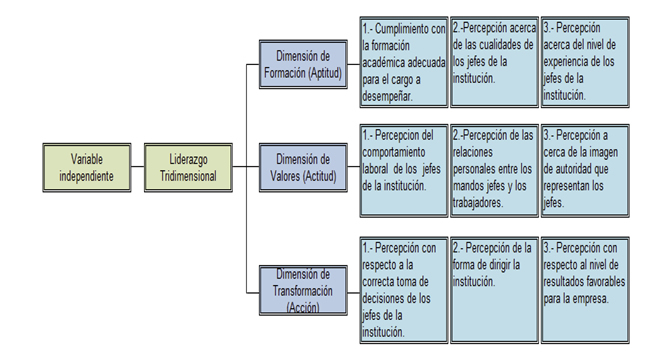
Source: Authors, 2016
The dependent variable, which is the labor motivation variable, is divided into the following dimensions and indicators:
Table 3. Operationalization of the dependent variable.
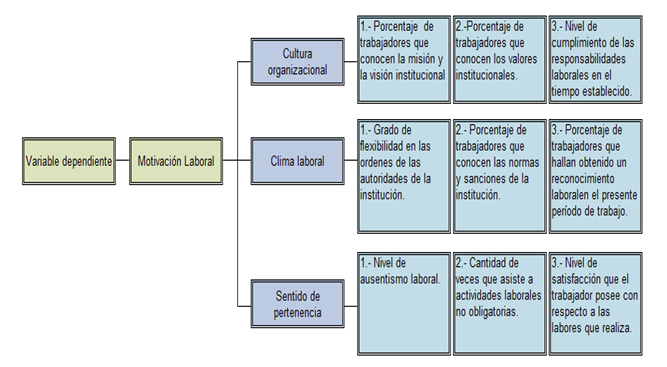
Source: Authors, 2016
3.6. Population and Sample
For this thesis paper, the whole staff of the Society Pro-rehabilitation of the Crippled (S.E.R.L.I.), which is equivalent to 53 people, has been chosen as a study population. When using the method of case study, it is necessary to focus on analyzing all the members of the population; therefore, the sample of studies is equivalent to the population.
3.7. Research techniques
In order to be able to elaborate this research paper, it is necessary to establish a series of quantitative and qualitative techniques that will allow us to analyze the eighteen indicators, which will be performed in S.E.R.L.I. The questionnaire is mixed, ie it is composed of open questions to quantitatively analyze the answers, but it will also be composed of closed questions to qualitatively analyze the answers and try to contrast the answers between quantitative and qualitative, and thus establish the reality of S.E.R.L.I. in terms of leadership and labor motivation.
In order to elaborate this academic work, two variables have been evaluated: Three-dimensional leadership: Labor motivation. From them, the following dimensions emerge: Training (Aptitude). Values ??(Attitude). Working environment. Sense of belonging. Highlighting the following indicators: Academic training. Labor behavior of the bosses. Work Acknowledgments. Satisfaction of the worker with his tasks.
4. DISCUSSION
Variable: Three-dimensional Leadership
Dimension: Training (Aptitude)
Indicator: Academic training
Technique: Quantitative using multiple-choice questions.
1. Do you have an academic title?
Table 4. Having an academic title.
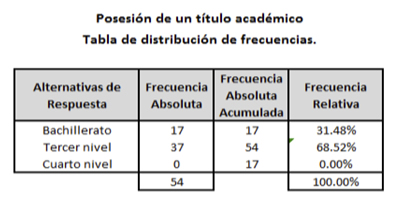
Source: Authors, 2016
Graph 1. Having an academic title. Source: Authors, 2016
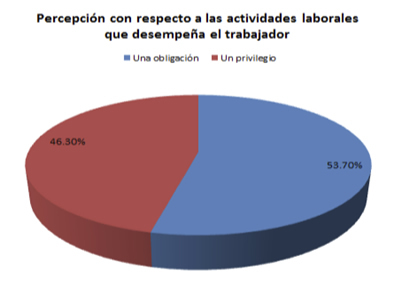
Analysis: the information we obtained indicates that more than half of respondents, represented by 68.52%, have a third-level degree, and 31.48% are bachelors. It is worth mentioning that more than half of the workers are qualified, yet none has been motivated to get a fourth-level degree, so its representation is 0%.
Variable: Three-dimensional Leadership
Dimension: Values ??(Attitude)
Indicator: Labor behavior of bosses
Technique: Quantitative using image insertion
2. In the following image, two scenarios are presented, which of the two options do you consider to reflect the behavior of your boss?
Image 1. Image analysis reflecting the behavior of bosses. Source: Authors, 2016
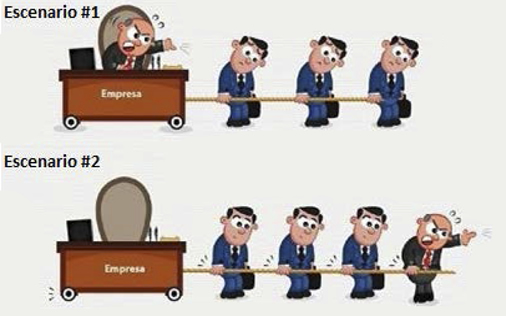
Table 5. Image analysis reflecting the behavior of bosses.
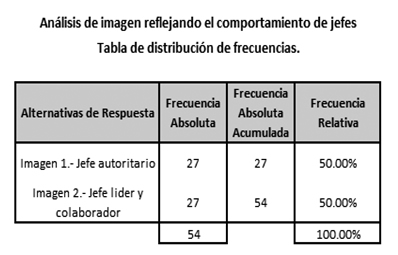
Source: Authors, 2016
Graph 2. Image analysis reflecting the behavior of bosses. Source: Authors, 2016
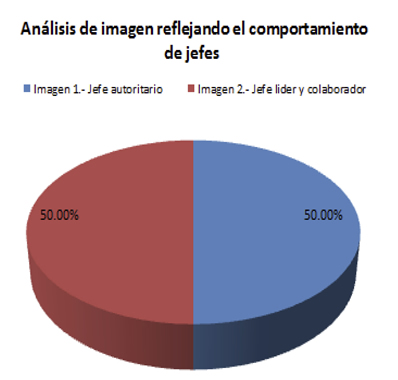
Analysis: When consulting the respondents through the technique of image insertion, it is established that 50% of respondents identify themselves with the first option that is an image of an authoritarian boss, and the other 50% of respondents relate their bosses to the second option that is the image of a collaborating boss who reflects leadership.
Variable: Labor motivation
Dimension: Working environment
Indicator: Labor Acknowledgments
Technique: Quantitative using open questions
3. Describe a scenario in which you have been recognized at work by your
Table 6. Scenarios of recognition of workers.
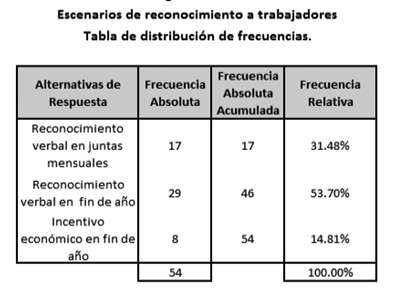
Source: Authors, 201
Graph 3. Scenarios of recognition of workers. Source: Authors, 2016
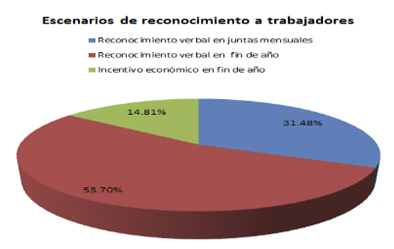
Analysis: Most respondents, with 53.70%, mentioned that they received verbal recognition at the end of the year, 31.48% indicate that they received verbal recognition at monthly meetings and only 14.81% received an economic incentive at the end of the year.
Variable: Labor motivation
Dimension: Sense of belonging
Indicator: Satisfaction of the worker with his tasks
Technique: Quantitative using multiple-choice questions
4. How do you rate your work activity in the company?
Table 7. Perception with respect to the work activities performed by the worker.
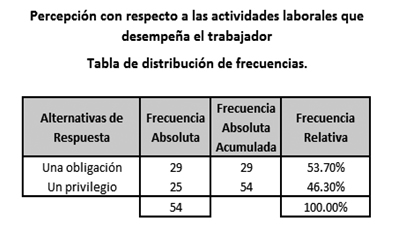
Source: Authors, 2016
Graph 4. Perception with respect to the labor activities that the worker performs.
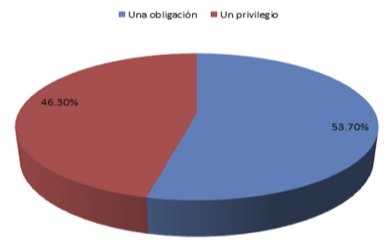
Source: Authors, 2016
Analysis: 53.70% of respondents regard their work activities as an obligation; however, 46.30% of workers indicated that it is a privilege to carry out the functions under their responsibility.
According to the information obtained in the process of approach and the analysis of the variable Leadership, it can be determined that top bosses do efficiently control the work of their collaborators and that, in general, they react well to criticism; this has allowed workers to recognize the good qualities of their bosses when they hold their position, whether due to their training, capacity, level of demand and experience they project. It has been shown that employees consider their bosses to have an adequate level of experience and that this is due to the relationship between their academic training and the experience they have in the position they hold; for that reason they are able to efficiently and effectively solve the problems that arise in the work environment.
The collaborators mention that their superiors have an adequate labor behavior in the institution; however, 50% rate leaders as authoritarian bosses who exert high levels of pressure on the human talent. On the other hand, the other 50% of the sample considers that there is a hierarchical group that demonstrates the attitude, aptitude and action of a three-dimensional leader who is collaborator and sympathetic with the employees.
The information we obtained allows us to determine that the labor relationship between top bosses and employees is founded on the fact that 75.93% mention that their bosses know how to listen and solve conflicts in the work environment, that the most outstanding values in that relationship are responsibility and honesty. 62.96% consider that the treatment of their bosses is normal and that constructive criticisms are constantly generated individually to avoid hurting susceptibilities. The image of the authorities is a symbol of respect, loyalty and leadership, but workers say that bosses reflect inflexibility and therefore there is no understanding of certain personal problems that workers have.
Human talent considers that bosses, in most cases, make correct decisions because they always aim to achieve the goals; in addition, the general perception compared to the results of the company indicates corroborates the proper decision making. When analyzing the way of leadership of bosses, it is possible to notice the importance given to correct management of resources based on the organization, which is intended to be achieved by fostering synergy in the work teams. For all of the above, it can be determined that the three-dimensional leadership is present in great proportion, in management of the southern headquarters of SERLI.
When analyzing the results related to the labor motivation variable, it is evident that the collaborators know the mission and the vision of the company; however, they demonstrate that they do not agree with what is manifested in them, the reason why a sense of belonging of the employees towards the organization is not demonstrated. It is possible to determine that, in the organization, there is labor recognition, the great disadvantage is that, in most cases, recognitions are verbal and not economic as the worker wishes. Even so, the workers are responsible and fulfilling with the entrusted goals, reflecting a low level of work absenteeism.
When trying to test the level of integration of workers in non-compulsory labor activities, most of them refuse to spend more of their time in the company because there is evident job dissatisfaction with respect to the ways to motivate the worker, this is why 51.85% of workers do not reflect a level of satisfaction with their assigned functions in such a way that their work is fulfilled from the perspective of performing it as an obligation and not as a privilege of professional fulfillment.
In conclusion, it is important to recognize that in the work environment there are forms of labor motivation, the big drawback is that workers prefer to receive economic rewards and not verbal recognition, so there is a high level of job dissatisfaction in human talent.
5. CONCLUSIONS
Through the field research carried out in the southern headquarters of S.E.R.L.I., the following can be determined:
1. The first specific objective indicates the establishment of the ways used by the institution in the last three years to motivate its staff; through surveys, we could determine that the institution motivates its staff in several ways, in most cases the recognition is verbal but, at the end of the year, on other occasions, the recognition is in monthly meetings. Only a small part of the workers represented by 14.81% mention having been rewarded through an economic incentive and at the end of the year. Therefore, it can be concluded that in S.E.R.L.I. its workers are motivated in the ways that were previously mentioned.
2. The second specific objective invites to detect the type of leadership that the bosses of S.E.R.L.I. have been applying for the last three years; surveys show that 50% of employees of the institution consider their bosses to have an authoritarian image that does not reflect leadership but imposition, and the other 50% of workers consider their bosses to have an image of leading and collaborative boss, reflecting a three-dimensional leadership formed by attitude, aptitude and action of the leader. Thus, it can be concluded that the institution has two types of leadership, authoritarian leadership and three-dimensional leadership represented in the same magnitudes.
3. The third specific objective indicates the establishment of a diagnosis of the current state of labor motivation in the institution under study. Respondents indicate that any fulfillment of goals and any work effort must be encouraged, but it is classified as something unfair, defined by 85.19% of workers. All workers mention that if there is an influence between labor recognition and their productivity and that the way of recognizing must be economic, driven by 90.74% of workers.
4. The fourth and last specific objective mentions the development of a strategic plan of systematic leadership that manages labor motivation in the institution and, for this, in the proposal of the present paper, we establish the parameters and the way to develop the strategic plan of systematic leadership through three-dimensional leadership, which generates the necessary motivation in workers.
5. With all of the aforementioned, it can be concluded that, by achieving the four specific objectives, we have achieved the general objective in which the analysis of the influence of leadership on labor motivation of the staff of the southern headquarters of the Ecuadorian Society Pro-Rehabilitation of the Disabled in 2016 was established.
6. REFERENCES
1. Chiavenato I (2011). Administración de Recursos Humanos. México DF, México: Mc Graw Hill.
2. Colorado G (2014). Liderazgo y Personalidad (Tesis de pregrado). Xalapa-Enríquez, Veracruz, México: Universidad Veracruzana.
3. Martínez P (2009). Formación basada en competencias. Revista Investigación Educativa, XXVII, 125-147.
4. Mondy R (2005). Administración de recursos humanos. México DF: Pearson.
5. Robbins S (2010). La administración. Missouri: Prentice-Hall.
6. Sánchez J (2015). Percepciones sobre el liderazgo. Ra Ximhai, XI, 161-170.
7. Solf A (2006). Motivación intrínseca laboral y su relación con las variables de personalidad orientación a la meta y tesón. Revista Persona, IX, 111-126.
8. Terrazas R (2015). Liderazgo tridimensional. Perspectivas, XXXV, 7-28.
9. Viveros J (2003). Liderazgo, comunicación efectiva y resolución de conflictos. Santiago de Chile.
AUTHORS
Vicente N. Checa Calderón
Master of Administration and Management of Companies, Business Technological University of Guayaquil, Commercial Engineer, Specialization in Finance and Accountant.
Tomás Humberto Rodríguez-Caguana
Doctorate in Philosophy. Master of Organizational Communication. Graduate in Communication. Bachelor of Communication. Research Manager at the University of Guayaquil.